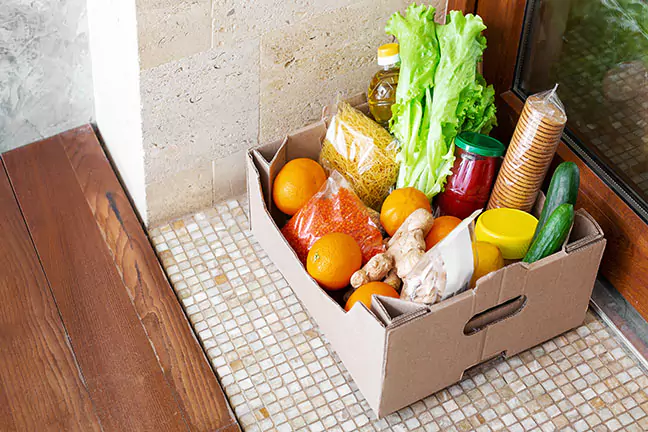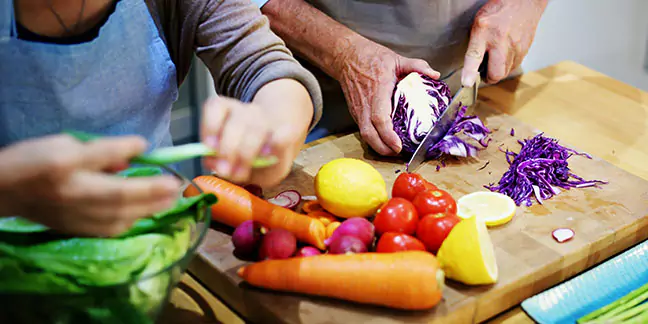As prices of food and other essential items continue to go up, are you like many others finding yourself needing to stretch your budget more frequently? While inflation can make financial planning difficult for people of all ages, it may be particularly challenging for seniors who are living on their retirement savings.
For a glimpse of how tough things are, just take a look at the latest Consumer Price Index, which is an indicator of inflation. The index rose by 0.4% in February and is showing little signs of slowing. What worse is that many experts are suggesting prices may go up further in the near future.
So if you are a senior living on a budget, is there anything you can do to ensure access to proper and affordable meals every day? One simple option is to consider changing the way you shop or eat. For example, you can look for discount items, choose bulk options or start making your own meals.
In addition, there are a wide range of food assistance programs for seniors in the country that can help ease your worries. In this blog, we’ll share some of the most useful resources that offer free or discounted groceries.
Ready to learn more? Watch the video below or keep reading.
The Supplemental Nutrition Assistance Program (SNAP)
SNAP, or food stamps, is a federally funded program that provide food support for low income families and individuals, including seniors. The program aims to reduce food insecurity by offering financial assistance to eligible individuals and families to ensure their access to nutritious food.
SNAP benefits are deposited directly into Electronic Benefits Transfer (EBT) cards, which can be used the same way as debit cards to buy eligible food from participating grocery stores, supermarkets or Farmers’ Markets. You are allowed to purchase fresh fruits and vegetables, meat, dairy products and other healthy food items with SNAP benefits.
To qualify for SNAP benefits, you or your household must meet certain requirements , including identity (U.S. citizen or legal alien), work requirements and household income limits. Each state has a different application process, you can contact your state agency to get more information or apply directly.
In most cases, your state agency or local SNAP office will process your application and provide you with the results within 30 days of submitting your application. Then you need to provide relevant supporting documents and participate in an eligibility interview.
Once you passed the interview, you’ll be ready to receive your SNAP benefits.

Medicare Food Allowance
Your Medicare coverage may include free grocery benefits, but this is not the case if you only have basic coverage such as Medicare Parts A or B.
Certain Medicare Advantage plan offer supplementary benefits, such as healthy meal delivery services. You can check your policy details or consult your insurance agent to find out if your Medicare Advantage plan comes with a grocery benefit that you may qualify for. If you are eligible, you will likely receive a flex card that can be used for grocery shopping.
The specific amount of grocery benefits you are entitled to varies depending on your plan and where you live. Some plans may even allow you to order groceries online and have them delivered to your home.
Special Needs Plans (SNPs)
If you have specific health conditions or health care needs, or if you have Medicaid in addition to your Medicare coverage, you may be eligible for an Special Needs Plan, which is a special type of Medicare Advantage Plan.
An SNP covers the same Medicare Part A and Part B benefits that all Medicare Advantage Plans offer. However, it also provides extra services tailored to meet the special needs of the groups it serves, including grocery allowance.
Unlike other types of Medicare Advantage Plans, enrolling in an SNP requires meeting specific eligibility requirements. These include:
Having both Medicare Part A and Part B.
Residing within the plan’s service area.
Qualifying for one of the following 3 types of SNPs:
Dual Eligible SNP (D-SNP) – Eligible for both Medicare and Medicaid
Chronic Condition SNP (C-SNP) – Experiencing one or more severe or disabling chronic conditions, such as coronary artery disease, congestive heart failure, cancer, and end-stage liver disease.
Institutional SNP (I-SNP) – Living in the community but requiring facility care, or residing (or expected to live) for at least 90 consecutive days in a facility
The Seniors Farmers' Market Nutrition Program (SFMNP)
The Seniors Farmers Market Nutrition Program (SFMNP), a federal program administered by state agencies, is created to help low-income older adults access locally grown vegetables, fruits, and herbs at farmers’ markets, roadside stands, and community supported agriculture programs.
To qualify for the program, you should be at least 60 years old and have a household income no more than 185% of the federal poverty level.
Commodity Supplemental Food Program (CSFP)
The Commodity Supplemental Food Program (CSFP) provides low-income seniors who are at least 60 years old with a monthly package of healthy food to help improve their health.
US Department of Agriculture (USDA) is responsible to distribute food and administrative funds to participating states and Indian Tribal Organizations. Each state sets their own income limits and local agencies determine the eligibility of applicants, distribute the foods, and provide nutrition education. Contact your state distributing agency to get more details.

The Emergency Food Assistance Program (TEFAP)
The Emergency Food Assistance Program (TEFAP) is a federal program that provides free emergency food assistance to individuals with low income. The program is administered by USDA, which distributes 100% American-grown foods and administrative funds to states. States then allocate the food to local food banks and other agencies. These agencies, such as soup kitchens and food pantries, serve the food to those in need.
You may access TEFAP foods by visiting food pantries or having meals at soup kitchens. If you meet the specific income standard set by your state, you may also be eligible to take TEFAP food home.
By reaching out to your state distributing agency, you can gather more information on the requirements, location of food distribution sites and how to access the assistance.
Senior Food Pantries
Senior food pantries is another valuable resource that offers free food to seniors. These food pantries typically distribute a variety of food items, including fresh produce, canned goods, and dairy products.
You can reach out to local community organizations or senior centers to inquire about the location of senior food pantries in your neighborhood, application process and documents required.
Home-Delivered Nutrition Programs
Home-delivered meal programs provide nutritious meals to seniors who have difficulty accessing congregate meal sites. These nutritionally balanced meals are prepared by qualified providers and delivered directly to your doorstep.
Nutrition Services of the Older Americans Act
The Older Americans Act Nutrition Services provides nutrition services for adults age 60 and older, such as heathy home-delivered meals, meals served at senior centers, nutrition education and counseling. Eligibility for these services is subject to states and local organizations.
Meals On Wheels
Meals on Wheels is a network of community-based, non-profit programs that provide healthy meals and other support for older adults who have difficulties in shopping or making meals on their own. The age requirements can vary depending on the specific program and the area they serve.
If you are interested in getting help from one of these programs, the best thing to do is to contact them directly. They can give you all the information you need about who is eligible and how to apply. Some programs may require a referral letter from a doctor or social worker.
Increase Your Grocery Budget
Besides taking advantage of food programs, there are other creative ways to make the most of a fixed income. Many older adults may be not aware of the range of government benefits they are eligible for, such as Medicare and the Affordable Connectivity Program (ACP). By leveraging these benefits, you can effectively lower your medical and communications expenses, freeing up more money for groceries and other essential needs.

ACP and Lifeline Program
The ACP and the Lifeline Program provide discounted mobile and internet services to eligible low income individuals and families across the nation. If you qualify for SNAP benefits, there’s a high chance that you will also be eligible for these two programs.
What makes it even better is you can enjoy extra benefits by signing up ACP or Lifeline directly with providers such as EASY Wireless. Residents living in specific states may even score a FREE smartphone! Here’s what the EASY Wireless Unlimited Plan includes:
FREE Unlimited Data
FREE Unlimited Talk
FREE Unlimited Text
FREE SIM Card Kit and Activation
Choose to Keep Your Number or Get a New One
Visit one of the EASY Wireless’s retail stores, or simply get started by clicking the below:
Start Saving Today!


